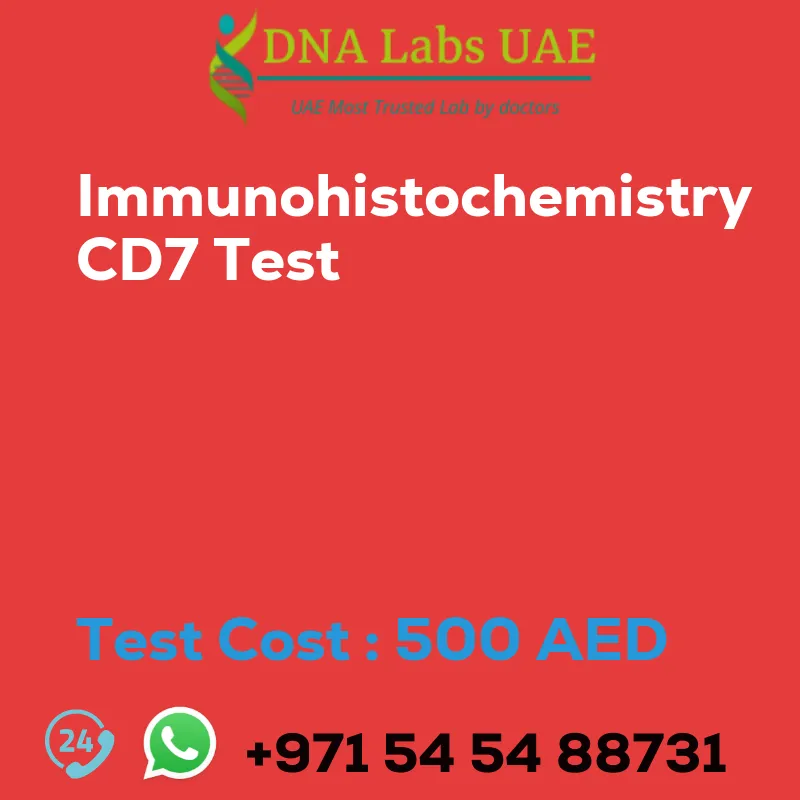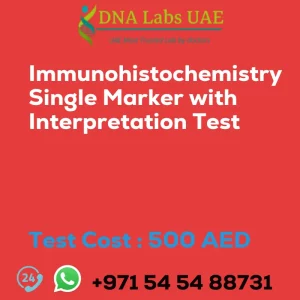IMMUNOHISTOCHEMISTRY CD7 Test Cost AED:500.0 Symptoms Diagnosis
At DNA Labs UAE, we offer the IMMUNOHISTOCHEMISTRY CD7 test at a cost of AED 500.0. This test is used to detect specific proteins in tissues using antibodies. CD7 is a cell surface glycoprotein that is expressed on T cells, natural killer (NK) cells, and a subset of hematopoietic progenitor cells. It is commonly used as a marker to identify T-cell lymphomas and leukemias.
Test Details
The CD7 test in immunohistochemistry involves several steps:
- Tissue preparation: Tissue samples are collected and fixed in formalin. They are then embedded in paraffin wax and sectioned into thin slices.
- Deparaffinization: The paraffin wax is removed from the tissue sections using xylene or other clearing agents.
- Antigen retrieval: The tissue sections are subjected to heat-induced antigen retrieval to unmask the CD7 antigen and enhance its accessibility to antibodies.
- Blocking: Non-specific binding sites on the tissue sections are blocked using a protein-based blocking reagent.
- Primary antibody incubation: The tissue sections are incubated with a primary antibody specific to CD7.
- Secondary antibody incubation: After washing off unbound primary antibody, the tissue sections are incubated with a secondary antibody conjugated to a detection system.
- Visualization: The detection system used in the secondary antibody can be enzymatic or fluorescent.
- Counterstaining: A counterstain is applied to enhance contrast and visualize tissue morphology.
- Examination: The tissue sections are examined under a microscope to visualize the presence and distribution of CD7-positive cells.
Pre Test Information
Before undergoing the CD7 test, please provide a copy of the Histopathology report, site of biopsy, and clinical history.
Report Delivery
The report for the CD7 test will be delivered daily by 6 pm for samples, 5 days for report blocks, 5 days for tissue biopsies, and 7 days for tissue large complexes.
Test Department
The CD7 test is conducted in the Histology department by our team of oncologists and pathologists.
Symptoms and Diagnosis
The CD7 test in immunohistochemistry helps in the diagnosis and classification of T-cell lymphomas and leukemias. It provides valuable information about the expression pattern of CD7, which can aid in determining the lineage and differentiation stage of the malignant cells.
Sample Condition
To perform the CD7 test, please submit tumor tissue in 10% Formal-saline or a Formalin-fixed paraffin-embedded block. The sample should be shipped at room temperature.
Doctor
If you have any further questions or concerns about the CD7 test, please consult with our oncologists or pathologists.
| Test Name | IMMUNOHISTOCHEMISTRY CD7 Test |
|---|---|
| Components | |
| Price | 500.0 AED |
| Sample Condition | Submit tumor tissue in 10% Formal-saline OR Formalin fixed paraffin embedded block. Ship at room temperature. Provide a copy of the Histopathology report, Site of biopsy and Clinical history. |
| Report Delivery | Sample Daily by 6 pm; Report Block: 5 days Tissue Biopsy: 5 days Tissue large complex : 7 days |
| Method | Imunohistochemistry |
| Test type | Cancer |
| Doctor | Oncologist, Pathologist |
| Test Department: | HISTOLOGY |
| Pre Test Information | Provide a copy of the Histopathology report, Site of biopsy and Clinical history. |
| Test Details |
Immunohistochemistry (IHC) is a technique used to detect specific proteins in tissues using antibodies. CD7 is a cell surface glycoprotein that is expressed on T cells, natural killer (NK) cells, and a subset of hematopoietic progenitor cells. CD7 is commonly used as a marker to identify T-cell lymphomas and leukemias. The CD7 test in immunohistochemistry involves the following steps: 1. Tissue preparation: Tissue samples are collected and fixed in formalin. They are then embedded in paraffin wax and sectioned into thin slices. 2. Deparaffinization: The paraffin wax is removed from the tissue sections using xylene or other clearing agents. 3. Antigen retrieval: The tissue sections are subjected to heat-induced antigen retrieval to unmask the CD7 antigen and enhance its accessibility to antibodies. This is typically done by heating the sections in a buffer solution. 4. Blocking: Non-specific binding sites on the tissue sections are blocked using a protein-based blocking reagent (e.g., serum or bovine serum albumin). This step helps reduce background staining. 5. Primary antibody incubation: The tissue sections are incubated with a primary antibody specific to CD7. The primary antibody binds to the CD7 antigen present on the T cells, NK cells, or hematopoietic progenitor cells. 6. Secondary antibody incubation: After washing off unbound primary antibody, the tissue sections are incubated with a secondary antibody conjugated to a detection system. The secondary antibody recognizes and binds to the primary antibody. 7. Visualization: The detection system used in the secondary antibody can be enzymatic (e.g., horseradish peroxidase) or fluorescent. Enzymatic detection systems involve the addition of a chromogenic substrate that produces a visible color change upon enzymatic reaction. Fluorescent detection systems emit light of a specific wavelength when excited by a specific light source. 8. Counterstaining: To enhance contrast and visualize tissue morphology, a counterstain (e.g., hematoxylin) is applied to the tissue sections. 9. Examination: The tissue sections are examined under a microscope to visualize the presence and distribution of CD7-positive cells. Positive staining appears as brown color (enzymatic detection) or fluorescent signal (fluorescent detection). The CD7 test in immunohistochemistry helps in the diagnosis and classification of T-cell lymphomas and leukemias. It provides valuable information about the expression pattern of CD7, which can aid in determining the lineage and differentiation stage of the malignant cells. |







